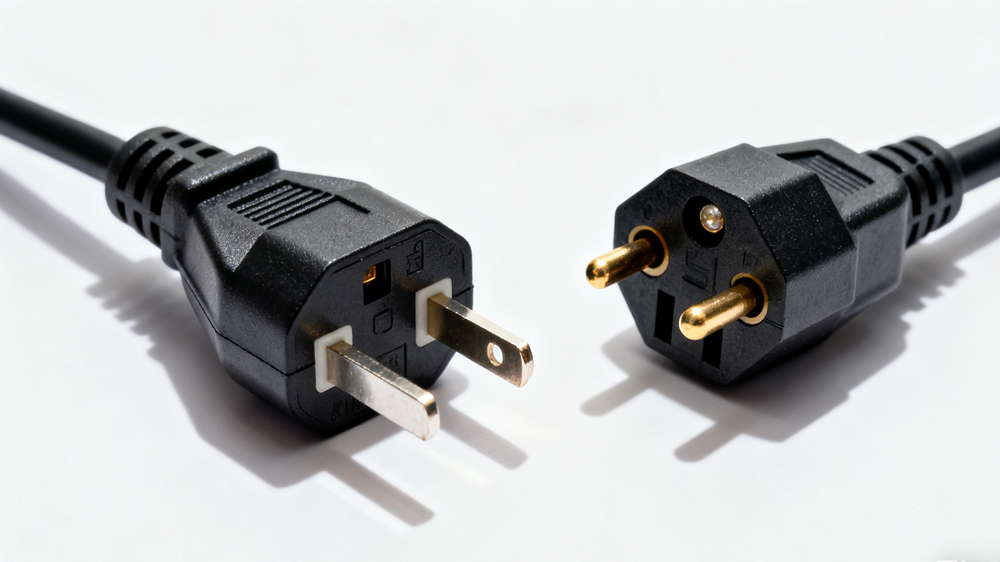Two of the most common types of power cord connectors in use globally are NEMA and IEC. While both serve the same fundamental purpose—providing electrical connections—they are designed for different regions, standards, and applications.
Understanding the differences between IEC and NEMA connectors is very helpful for anyone working with electronic devices, data centers, or industrial equipment.

NEMA Connectors
NEMA, or the National Electrical Manufacturers Association, sets the standards for electrical connectors primarily used in North America. These connectors are commonly seen in household outlets, office equipment, and industrial machinery.
NEMA connectors are designed with specific configurations that indicate their voltage, current, and grounding type. For example, the NEMA 5-15P is one of the most common plugs in homes, rated for 125 volts and 15 amps.
NEMA connectors are recognised for their durability and ability to handle higher current loads. They typically feature three prongs: two for power and one for grounding, ensuring a safer electrical connection. Different NEMA designs accommodate a range of voltages and current ratings, providing flexibility for various applications.
IEC Connectors
IEC, which stands for the International Electrotechnical Commission, sets the global standards for electrical connectors, focusing mainly on data centers, office equipment, and international appliances. IEC connectors are often used in equipment such as computers, servers, and medical devices. The most common IEC connector types include C13, C14, C19, and C20.
IEC connectors are designed to provide a universal fit for electrical devices, making them ideal for international use. They are standardised to ensure that devices can be safely powered anywhere in the world, provided the correct plug adapter is used for local sockets.
IEC connectors typically have a compact design and can accommodate different power ratings depending on the specific type.
Primary Difference NEMA vs IEC
NEMA and IEC connectors differ mainly in design, regional use, and function:
- Regional Usage: NEMA is common in North America for higher currents and voltages in homes and industry.
- Global Standards: IEC follows international standards for use in data centres, IT, and appliances.
- Shape: NEMA plugs have flat prongs with grounding; IEC connectors are rectangular or square for secure connections.
- Application: NEMA handles higher power loads; IEC suits compact and sensitive electronics.
- Safety: Both ensure safe, consistent power, with design differences affecting compatibility with devices and systems.
Application and Use
NEMA connectors are widely used in North American homes and businesses, powering computers, office equipment, kitchen appliances, and other electrical devices. They provide robust performance for both everyday and heavier-duty applications.
IEC connectors, on the other hand, are preferred in data centers, server rooms, and international offices, offering a standardised and reliable connection that supports a wide range of electronic devices globally, ensuring consistent power delivery and compatibility across regions.
Voltage and Current Ratings
Voltage and current ratings are key when choosing power cord connectors. NEMA connectors generally handle 125V to 250V and 15A to 50A, making them suitable for residential and industrial use. IEC connectors support 125V to 250V and 2.5A to 16A, sufficient for most electronic devices and data center equipment, while maintaining reliable and safe operation.
How are cables classified under NEMA?
Cables under NEMA standards are classified based on plug configuration, voltage, and amperage. Each type of NEMA connector has a unique designation, such as NEMA 5-15, NEMA 6-20, or NEMA 14-30.
This classification helps users identify the appropriate cable for a particular device or application. The classification also ensures compatibility with electrical outlets and provides guidance on safe power distribution.
How are cables classified under IEC?
IEC cables are classified by their connector types, such as C13, C14, C19, and C20, and by their voltage and current capacities. IEC classifications are standardised internationally, making it easier to choose compatible power cords for electronic equipment worldwide.
The classification system also provides essential safety information, including the maximum current and voltage each connector can safely handle.
Ensure the Safety of Your Power Cables
Ensuring the safety of power cord connectors is essential for protecting both devices and users. Always select the right connector type for your equipment, considering voltage, current, and grounding requirements.
Avoid using adapters or modifying cords, as this can compromise safety. Regularly inspect power cords for signs of wear or damage, and replace them when necessary. Proper cable management, including avoiding tangling or excessive bending, can also prolong the lifespan of your cords and maintain safe operation.
Conclusion
Choosing the right power cord connectors ensures safe and reliable power delivery. NEMA connectors are common in North America for high-current applications, while IEC connectors provide international compatibility for electronic devices.
Knowing the differences between IEC and NEMA connectors helps maintain equipment safety and performance, and simplifies setup for home or professional environments.
 +86 138-6870-3133
+86 138-6870-3133 sales@lanzmfg.com
sales@lanzmfg.com EN
EN CN
CN Search
Search